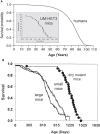Somatotropic Axis, Pace of Life and Aging
- PMID: 35909509
- PMCID: PMC9329927
- DOI: 10.3389/fendo.2022.916139
Somatotropic Axis, Pace of Life and Aging
Abstract
Mice with genetic growth hormone (GH) deficiency or GH resistance live much longer than their normal siblings maintained under identical conditions with unlimited access to food. Extended longevity of these mutants is associated with extension of their healthspan (period of life free of disability and disease) and with delayed and/or slower aging. Importantly, GH and GH-related traits have been linked to the regulation of aging and longevity also in mice that have not been genetically altered and in other mammalian species including humans. Avai+lable evidence indicates that the impact of suppressed GH signaling on aging is mediated by multiple interacting mechanisms and involves trade-offs among growth, reproduction, and longevity. Life history traits of long-lived GH-related mutants include slow postnatal growth, delayed sexual maturation, and reduced fecundity (smaller litter size and increased intervals between the litters). These traits are consistent with a slower pace-of-life, a well-documented characteristic of species of wild animals that are long-lived in their natural environment. Apparently, slower pace-of-life (or at least some of its features) is associated with extended longevity both within and between species. This association is unexpected and may appear counterintuitive, because the relationships between adult body size (a GH-dependent trait) and longevity within and between species are opposite rather than similar. Studies of energy metabolism and nutrient-dependent signaling pathways at different stages of the life course will be needed to elucidate mechanisms of these relationships.
Keywords: aging; growth hormone; lifespan; longevity; mutant mice; pace of life; somatotropic axis.
Copyright © 2022 Bartke.
Conflict of interest statement
The author declares that the research was conducted in the absence of any commercial or financial relationships that could be construed as a potential conflict of interest.
Figures

References
-
- Arias E. United States Life Tables, 2010. Natl Vital Stat Rep (2014) 63(7):1–63. - PubMed
Publication types
MeSH terms
Substances
Grants and funding
LinkOut - more resources
Full Text Sources

